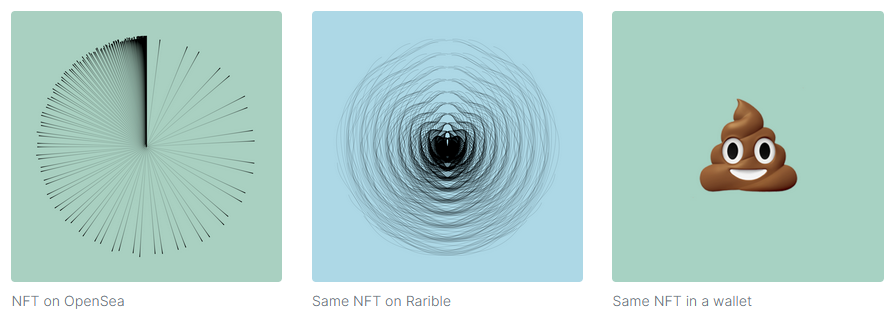
Moxie Marlinspike is the founder of the encrypted messaging app Signal, and his recent post criticizing web3 is insightful and great, even though it centers largely on this Banksyesque prank he played at the NFT marketplace OpenSea, where he sold a digital artwork that displays as a poop emoji when viewed in a crypto wallet (see illus. below). But he falls short in failing to examine the real and useful things people have done and are doing with blockchain; things unrelated to finance or money.
Moxie’s post is different from and far better than most web3 criticism in its breadth of vision. He isn’t concerned with apes or Beeples, choosing instead to consider web3 as a new stage in the whole evolving ecosystem of the internet. From this vantage point he argues that centralization is preferable to decentralization, in some ways.
After 30+ years, email is still unencrypted; meanwhile WhatsApp went from unencrypted to full e2ee [end-to-end encryption] in a year. People are still trying to standardize sharing a video reliably over IRC [Internet Relay Chat]; meanwhile, Slack lets you create custom reaction emoji based on your face.
Compelling examples for sure, though the glaring reason why the megaplatforms have both the means and the motive to move so fast—viz., profit, and more profit—goes unremarked. There is a lot of downside, as we’ve seen, in using a machine that exists for money, and that becomes infinitely, uncontrollably ravenous for more and more money. People are guaranteed to bring their greed with them wherever they go, so attempts at the corruption of any store of value are unavoidable, and crypto is no exception.
Moxie was able to make his shape-shifting poop emoji NFT because of certain inherent weaknesses in NFT specifications. He explained:
Instead of storing the data on-chain, NFTs instead contain a URL that points to the data. What surprised me about the standards was that there’s no hash commitment for the data located at the URL. Looking at many of the NFTs on popular marketplaces being sold for tens, hundreds, or millions of dollars, that URL often just points to some VPS running Apache somewhere.
He used the NFT spec to serve different images of the same NFT to viewers, based on the IP or User Agent of whoever wanted a look. However, the records of the underlying crypto transactions governing the NFT are intact, and don’t change from viewer to viewer; anyone can see them on Etherscan.io (a search service for the Ethereum ledger). In effect, the NFT is now a permanent record of the prank itself. (Something I might like to own, even, since I collect books and artifacts about hoaxes, like the original issue of Social Text in which the Sokal hoax first appeared.)
I’ve been working on using blockchain to guarantee the source and authenticity of published writing, and to develop new ways to compensate writers and artists more fairly. Back in 2017 when we were figuring out how to produce tamper-proof archives of news stories under the auspices of Civil, one of the big problems was cost; storing even a brief text directly on the Ethereum blockchain as an ordinary transaction was prohibitively expensive, even back then. So there was talk of moving the actual storage to the peer-to-peer InterPlanetary File System (IPFS), rather than archiving directly on Ethereum. I love IPFS, but even then we could envision the possibility of poop-emoji kinds of risks in entrusting archives to a file system that wasn’t guaranteed through a tamper-proof distributed ledger. Luckily, though, Walker Flynn, Toby Fox and a few other wizards at Civil drew inspiration from a group of brilliant Chinese #MeToo activists who’d developed a way to write a large amount of text directly to Ethereum, using the notes section, making the cost of direct archiving relatively trivial. And so we were able to do it. (There’s a long way to go to perfect this process, I hasten to add; for example, ETH prices have risen from around $130 in those days to roughly $3300 today, making transaction costs for the original method prohibitively expensive again, for now, on Ethereum at least.)
Anyway, I mention this point because the risks of taking sensitive material off-chain were evident a long time ago, and there were solutions taking shape even back then, and there can and will be better ones, provided we don’t give up.
It’s long been clear to me that a transparent balance between centralized and fully decentralized public blockchain-based systems can make a better internet possible. What (public, fully distributed, well-maintained) blockchains can do, if we’re lucky, is give ordinary people ways to help keep more centralized systems honest, by providing a permanent, tamper-proof place to look things up and know they are true.
I keep saying this, but it’s relevant: mocking the apparent eccentricity or foolishness of NFTs is easy, and also pretty superficial and misguided with respect to the broader context of the art world; most importantly, though, it is missing the infinitely larger creative picture of what blockchain is doing now. Those complaining about NFT energy use (using a smartphone! lol) should look into the burgeoning role of blockchain in climate action, intellectual property and many, many other emerging use cases.
Moxie sees web3 through a single lens, that of a technologist. He is a cryptographer, a specialist in security and a software genius. The whole internet is deeply based in the areas of his expertise, obviously but the internet is far more than technology: it’s the realization of the possibilities presented by technology, commerce and creativity, three elements held in an uneasy, ever-shifting tension. It’s this tension that will determine the fate of web3, just as it’s shaped the internet from the beginning: the tug-of-war that created Something Awful, Myspace, Facebook and the Internet Archive; Google and Wikipedia, Netflix and Amazon. Bitcoin, Ethereum and Solana.
I loved this part of Moxie’s post, a most useful and cogent place to focus criticism.
People are excited about NFT royalties for the way that they can benefit creators, but royalties aren’t specified in ERC-721, and it’s too late to change it, so OpenSea has its own way of configuring royalties that exists in web2 space. Iterating quickly on centralized platforms is already outpacing the distributed protocols and consolidating control into platforms [like OpenSea].
In other words, there’s no built-in solution for NFT royalties within Ethereum itself, and that’s bound to lead to centralization. This is inarguably true, and bad. However, it’s very early days yet; new entrants like LooksRare are already competing with OpenSea by offering a more decentralized approach.
The perils of web2 centralization are all too evident now. I’m confident that as the blockchain ecosystem matures—and, a big if, provided the profiteers and monopolists of web2 don’t ruin it—web3 will achieve many of the goals many, like me, have long had for it, including a transformed energy grid, streamlined, trustworthy global supply chains, permanent archiving to protect press freedom and the digital commons, and diminished corruption in government and finance.
I look to the new publicly distributed proof of stake blockchains to take Moxie’s cautions as a point of departure, and to build us a better mousetrap, now, before a mousetrap monopoly is able to form and choke the market, as so often happened in web2. As a writer and publisher, as an egalitarian and what used to be called a “netizen,” I am eager to help.
Boom Times is a blog about gambling, luck, money, greed, investing, blockchain technology and cryptocurrency.

